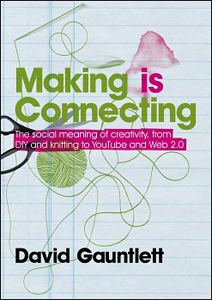The “Maker” Movement has been gaining a lot of steam in the past couple of years as the logical evolution of the Internet revolution, but making stuff for the Internet still doesn’t really get much respect as an outlet for creativity.
If you go to a cocktail party and tell people that you make furniture or jewelry in your spare time, then you’ll likely get a few interested (or at least polite) responses. If you mention that you’re, say, a blogger or fanvid maker, you’ll likely get at least one “living in your mom’s basement” or “sitting in your underwear” comment. Unless you are making money from your blog or videos, which is socially acceptable. The concept of “craft” and “hobby” is still very much connected to materials created by hand rather than ideas and less tangible “products” (writing, visual art, music) and the professionalization of creative expression has definitely contributed to the perception of hobbyist media-makers as mere amateurs.
Books like Clay Shirky’s Cognitive Surplus and Henry Jenkins’ Convergence Culture have stated a strong case for collaborative media making and digital sharing as a legitimate and even culturally relevant pastime. David Gauntlett’s Making is Connecting continues that line of thought, but also makes the connection between the more traditionally accepted outlets of creativity – say, knitting or sewing – to the work of a YouTube video maker, a iPhoneographer, and a remix artist. Drawing from decades of existing social science research on the nature of creativity and innovation, philosophical writings on creativity and community, and the usual suspects of current digital culture (Chris Anderson, Clay Shirky, etc.) Gauntlett’s aim is to stress the importance of what he calls “everyday creativity” as an individual outlet and the backbone of online and offline community building.
While mentions of YouTube and Wikipedia abound, this really isn’t a book about digital culture. Nor is it a book that explores creativity, innovation, and collaboration from a corporate or business context. Making is Connecting takes a different approach than similar writings that approach these topics by exploring broader concepts of creativity and community in the first couple of chapters. Chapter one is almost entirely a survey of sociological and philosophical literature on creativity, and Gauntlett’s personal, informal writing style makes it engaging enough to keep non cultural-studies geeks interested. Gauntlett takes a pre-digital historical perspective, looking at the Arts and Crafts movement of the late 1800’s and the 1990’s Riot Grrl zine scene, before jumping into digital culture in Chapter Three. Even then, Gauntlett doesn’t bother treading the same ground as, say Here Comes Everybody, and brings his own background as a creator of YouTube videos into the narrative, making it a book that has a lot in common with Jenkins “Acafan” approach to critical studies. The final three chapters of the book link to the previous three by exploring the nature of happiness and community building, how the exploration of everyday creativity lends to them both, and the tools and theoretical frameworks to that make such creativity possible for individuals and groups.
That’s a lot of ground to cover in one 250+ page book, particularly one that eschews the traditional case study model that similar books would use for this topic. Making is Connecting is indeed an ambitious book, but it doesn’t read like one. That’s a compliment. It covers a lot of ground and connects a wide range of disciplines and perspectives but Gauntlett isn’t trying to state a business case but is instead attempting to tie together the popular works of digital theorists with under-recognized works in other, equally important fields. It’s a humanist, holistic approach to digital studies that I hope may inspire other writers to approach such topics in a similar way.


